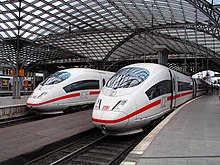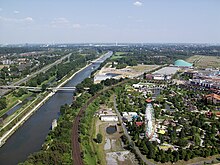Traffic in North Rhine-Westphalia
A characteristic of traffic in North Rhine-Westphalia is the large number of modes of transport and means of transport and the resulting high transport performance in North Rhine-Westphalia . With the exception of seaports , almost all forms of modern transport infrastructure are represented in North Rhine-Westphalia . Due to the central location of the state in the most important European economic area , its high population density and its industrial areas on the Rhine and Ruhr, North Rhine-Westphalia is one of the most densely developed areas in Europe.
Streets
The conurbations on the Rhine and Ruhr in particular are served by one of the densest road networks in Europe.
- The federal motorways 1 (Puttgarden-Saarbrücken), 3 (Emmerich-Passau), 31 (Emden-Bottrop), 33 (Osnabrück-Bad Wünnenberg), 43 (Münster-Wuppertal), 45 (Dortmund-Seligenstadt ) run in north-south direction ), 57 (Kleve-Köln), 59 (Dinslaken-Bonn) and 61 (Kaldenkirchen-Hockenheim).
- The federal motorways 2 (Oberhausen-Berlin), 4 (Aachen-Görlitz), 30 (Bad Oeynhausen-Bad Bentheim), 40 (Straelen-Dortmund), 42 (Kamp-Lintfort-Castrop-Rauxel) run in east-west direction , 44 (Aachen-Kassel), 46 (Heinsberg-Bestwig) and 52 (Elmpt-Marl).
The most heavily used motorway section in Germany is on the A3 near Cologne.
The length of the road network operated by the land is around 20,000 kilometers. Of these, around 2,220 km are motorways, 5,000 km are federal highways and 13,100 km are state roads. In addition to other municipal roads, there are also district roads with a total length of around 9,800 km.
rails
passenger traffic

The most important junction stations ( station category 1) for long-distance passenger rail transport are Dortmund , Düsseldorf , Duisburg , Essen , Köln Hbf and Köln Messe / Deutz .
Category 2 train stations are: Aachen , Altenbeken , Bielefeld , Bochum , Bonn , Düsseldorf Airport , Gelsenkirchen , Hagen , Hamm , Herford , Krefeld , Mönchengladbach , Münster , Oberhausen , Siegburg / Bonn , Solingen and Wuppertal .
The basis for the local rail passenger transport (SPNV) in North Rhine-Westphalia is an integral interval timetable (ITF) , which was developed in coordination with the four transport associations in North Rhine-Westphalia , the responsible parties for the local rail transport . North Rhine-Westphalia has three types of train that are coordinated with one another in terms of time and space:
- Regional Express (RE) with 26 lines
- Regional train (RB) with 57 lines
-
Train
- S-Bahn Rhein-Ruhr with 16 lines
- S-Bahn Hanover in Minden (S1) and between Lügde and Paderborn (S5)
In 2006 planning began for the Rhein-Ruhr-Express (RRX) . This is to connect the largest cities in North Rhine-Westphalia on the main route between Cologne and Dortmund and run every 15 minutes. Since the regionalization of the regional rail transport, besides the planning and design of the transport offers, the order of the respective lines has belonged to the task of the North Rhine-Westphalian special purpose associations (see also: Cooperation area ). In North Rhine-Westphalia there are currently transport contracts with different terms with all railway companies. Nine railway companies share operations on the local transport routes. The tariff barriers between the z. At present eight transport associations and communities have been dismantled by the NRW tariff . It is planned to reduce the traffic areas to three; today there are already three special purpose associations (Rhineland, Rhine-Ruhr, Westphalia).
See also: List of SPNV lines in North Rhine-Westphalia • List of passenger stations in North Rhine-Westphalia • IC lines • ICE lines
Freight transport
In the area of freight traffic counts Bahnhof Hagen-hall of the largest marshalling yards in Germany. In 2005, Cologne Eifeltor station was Germany's largest container transshipment station for combined rail / road freight traffic.
Airports
The most important intercontinental and not only nationwide important hub is Düsseldorf Airport . It is the third largest airport in Germany after the number of passengers. Around 22 million people depart from here every year with 80 different airlines to 180 destinations in 50 countries worldwide. Mainly continental flights start from Cologne / Bonn Airport , which is also one of the most important cargo airports in Germany. Other airports with international connections exist in Dortmund with Dortmund Airport , on the Lower Rhine in Weeze ( Airport Weeze ), in Greven with Münster / Osnabrück Airport and in Büren with Paderborn / Lippstadt Airport . Aachen has a stake in Maastricht Aachen Airport , which is located on Dutch soil . There are also smaller and regional airports, including the airfield Moenchengladbach , the airfield Essen / Mülheim , the Siegerlandflughafen in Siegen and Merzbrück Airport near Aachen.
Waterways and ports
The most important body of water in terms of traffic in North Rhine-Westphalia is the Rhine. In parts of the lower reaches, the Ruhr is also navigable and played an important role as a transport route for the coal and steel industry in the Ruhr area named after it. The Weser and parts of the Ems are also navigable throughout .
In Datteln , four cross channels , Rhine-Herne Canal , Wesel-Datteln canal (WDK), Datteln-Hamm canal and Dortmund-Ems Canal , which thus the major European hub for inland shipping form. One of the sights is the Henrichenburg ship lift . The Ruhrschifffahrtskanal also connects the Rhine (Duisburg port) with the Mülheim Rhine-Ruhr port. The Rhine, the Weser and, as an extension, the waterways located further to the east are connected to each other via the shipping canals mentioned and the Mittelland Canal in northern North Rhine-Westphalia . Both the largest inland port and the largest canal port in Europe are located in the Ruhr area. The Duisburg port “duisport”, which can be reached from the Rhine, the Ruhr and the Rhine-Herne Canal, is considered to be the transport hub for German inland shipping. Together with the private factory ports, it has an annual turnover of more than 100 million tons. In contrast, despite its size , the Dortmund Canal Harbor has lost a lot of its importance with the decline in steel production in recent decades. The most modern port is currently being built at the Minden waterway intersection with the Weser RegioPort .
Bike paths
→ Main article: NRW cycling network
The nationwide cycling network has a total length of approx. 13,800 km and is largely uniformly signposted. The content of the cycling network is divided into almost 50 themed routes. Following on from this, the municipal cycle traffic networks supplement this nationwide cycle path infrastructure. For this purpose, some municipalities are organized in the working group for bicycle-friendly cities, municipalities and districts in North Rhine-Westphalia . Münster is the unofficial cycling capital of Germany .
See also
- North Rhine-Westphalia's economy , especially for logistics services
Web links
Remarks
- ↑ https://rp-online.de/leben/auto/news/top-10-der-meistbefahrenen-autobahnen-deutschlands_bid-8908285
- ^ Ministry for Building and Transport of the State of North Rhine-Westphalia. Straßen.NRW: Road maintenance service
- ^ Ministry for Building and Transport of the State of North Rhine-Westphalia. Straßen.NRW: Annual Report 2006 ( Memento of the original dated May 29, 2015 in the Internet Archive ) Info: The archive link was inserted automatically and has not yet been checked. Please check the original and archive link according to the instructions and then remove this notice. (PDF; 1.6 MB)
Coordinates: 51 ° 29 ' N , 7 ° 33' E




